 |
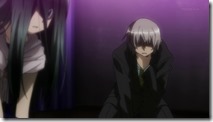 |
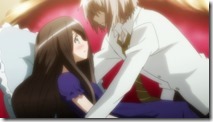 |
It’s not too often an anime makes me feel as if I’m seeing something truly fresh, but this one does so over and over.
I’ve made reference to “Strange & Beautiful” by Aqualung (Matt Hales) on the blog before – the album specifically, in reference to Zetsuen no Tempest. But I think somehow the song itself comes to mind even more when I watch Dansai Bunri no Crime Edge. It’s one of my favorites, not least because both the song and its subject matter are truth in advertising – strange and beautiful. It perfectly captures the dark side of love, along with the purity of feelings it brings. And of course, both parts of the title apply to Crime Edge, in spades.
The ability to provoke a reaction from an audience is a genuine talent that not every writer or director has – the art of the provocateur has been with us for as long as the written word (at least). But simply to provoke an audience (we see examples of this in anime from time to time, not least this season) does not, in my view, impart any special meaning on a work of art – it takes skill but is in itself a hollow act. To be able to provoke a reaction using character and pathos, on the other hand, is much more difficult to do and much more rarely achieved. By the same token, it’s that much more meaningful when it does happen. For me, Crime Edge is a glowing example of the latter achievement – it doesn’t seek merely to shock the audience for its own sake, but to reveal something about human nature and make us feel something genuine in the process. Clearly this is not the series for everybody, but those few of us that are following it are being treated to something truly strange and beautiful.
This series is succeeding on a good many levels, the most obvious being simple aesthetics. It’s clear now that the monochromatic nature of certain scenes is being used as a concession to the amount of violence they contain (this episode certainly has more than any previous) and as such, might legitimately be criticized for overuse. But in every other respect – design, art direction, cinematography, animation, background music – Crime Edge is a triumph. Every scene has BGM to fit the mood perfectly – it’s astonishing how many distinct pieces of music the soundtrack contains. And even in the black and while segments, the series takes a sort of film noir approach and takes advantage of the opportunities it provides for the use of shadows and stark contrasts. Visually, this series is head and shoulders above any other currently anime in terms of technique – the last series I can think of that even tried to go some of the places this one does is Nazo no Kanojo X, not the first nor the only similarity I’ve noted between the two shows.
The emotional palette of Dansai Bunri no Crime Edge is every bit as varied as the visual, and this episode was perhaps the most striking example yet. The series spends almost all of its time straddling a tightrope between extremes – beauty and horror, violence and tenderness, raw, brutish physical desire and selfless devotion. The very nature of the conceit at the heart of the series – the existence of Authors and their relationship with Insteads – plays with this notion. Certainly not every example of the relationship we’ve seen has been a loving one, but the best and most complex of them have – and each in their own way highlights the contradictory nature of the emotions at the heart of love. We see possessiveness, resentment, obsession – all on display in all their ugliness. But there’s something else there too, whether it be in the desperate clinging to sanity of the Byouinzaka sisters or the puzzle-piece fit of the couple who run Bar Velvet (episode 4). And at the heart of this, of course, is the relationship between Kiri and Iwai.
This episode spent most of its length squarely on the dark side of the emotional spectrum, dealing with the aftermath of last week’s cliffhanger. That means revealing who saved Kiri’s life by ordering someone in the opera boxes to take down Seigi – and that person is the busty blonde ojou-sama we met last week, Violet Witchie (Tamura Yukari). She’s the scion of the family that’s been overseeing the Authors and Queens (self-appointed) since the very first (which we saw re-enacted in the play last week), seemingly in charge of Gossip. And she’s none too happy about Seigi hijacking a party that was supposed to merely showcase the new Queen to the Gossip masses and trying to take down Kiri. She expresses sympathy for the Authors and Queen as “victims” but it’s clear she’s ruthless and considers it her divine right to decide their fates – a right she exercises in brutal fashion in having Seigi executed after he refuses her order to rein in his excesses. We see characters killed in anime quite often, but the immediacy and brutality of this one was quite intense to say the least – not least because Seigi didn’t die immediately, but labors on long enough for Kiri to find his dying form after he regains consciousness.
Both Kiri’s conversation with Violet and Seigi are fascinating in their own right. In the former, we see him quite rightly pin the blame for the curse on Violet’s ancestor, not the Queen – and then Iwai plead for his life. This is effectively a confession under the most trying of circumstances, but it’s all the validation Kiri could need that his feelings for Iwai are reciprocated. But Seigi’s defiant end is no less significant in that it amounts to the first time – in spite of all that’s happened – that Kiri has seen death. Seigi changed from a living, breathing person, someone he engaged in a conversation, to a lifeless object. That’s death – but the immediacy of it is a shocking revelation to a 14 year-old who might easily have convinced himself that such things could never really touch him, despite the dangers he’s faced and the non-lethal harm he’s inflicted on others in defense of Iwai.
I think it’s the aftereffects of this moment – which Iwai witnesses as well – that set up the final scene of the episode, one of the most raw and shocking displays of physical intimacy I’ve seen in anime . After a brief interview with Kozakura – herself denying her shock over Seigi’s death – Iwai and Kiri are left alone to consider what’s happened. A couple of episodes ago Dansai Bunri mentioned the “suspension bridge effect” and I think we see it very much in play with Kiri and Iwai. More than ever before, they’re forced to realize that either might be taken away from the other at any moment – death is stalking them all the time (as it is all of us, though perhaps not always with such immediacy). This makes them realize how deeply they need each other – and, they being hormonally-charged adolescents, manifests itself in a desperate physical longing (especially in Kiri’s case). This is surely a critical part of what love is, and Crime Edge shows it to us in all it’s raw ferocity, frightening and intoxicating at the same time. Again, this is the dance this series can perform like few others – revealing the light and the dark in stark contrast, each making the other that much more startlingly vivid.
Even for this show, I think this last sequence is as close to the edge as it’s managed to dance. If love itself is a study in contrasts so too it is with Kiri himself, who can be genuinely frightening in one moment and heartbreakingly kind and fragile in the next. When he says “I can’t contain myself any longer” it’s a tense moment, because of all the possibilities the context provides – and his display of affection for Iwai is both bizarre and sexually charged. These are middle-schoolers it must be said, and while no group is more sexually charged by nature, it’s shocking to see it portrayed so savagely here. Yet in the end he can’t bring himself to kiss her on the lips – just the forehead – much, I would say, to her disappointment. This is the engine that drives Crime Edge, that which makes everything else work and elevates it from provocation to art – the genuine magic in their relationship. Strange and beautiful it is, indeed, and there’s a chemistry (to use an overused term) between them that’s among the most powerful in recent anime. It’s a relationship that avoids cliché and trope to a remarkable degree, virtually a singularity, and it’s the heart of this wonderful and eccentric series.
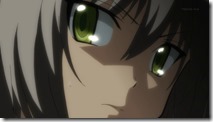 |
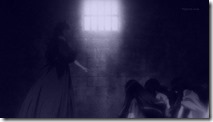 |
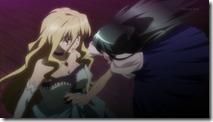 |
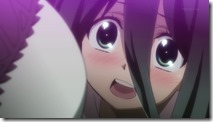 |
 |
 |
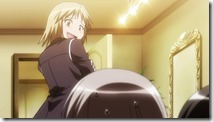 |
 |
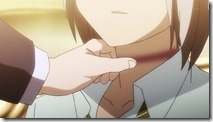 |
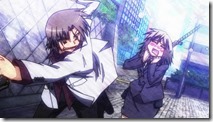 |
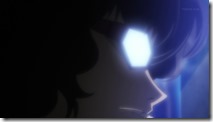 |
 |
 |
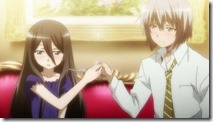 |
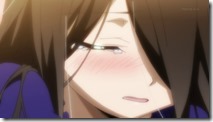 |
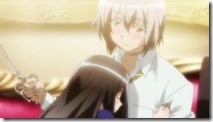 |
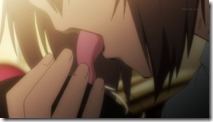 |
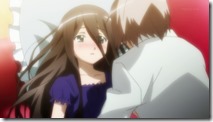 |
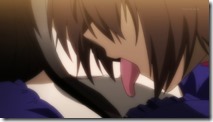 |
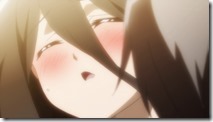 |
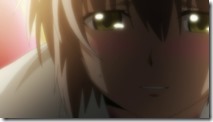 |
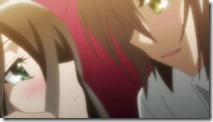 |
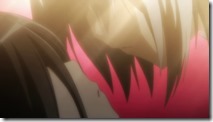 |
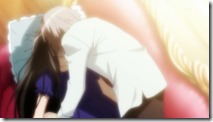 |
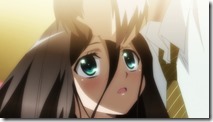 |
 |
 |
 |
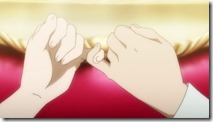 |
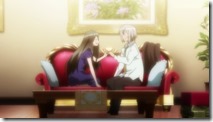 |


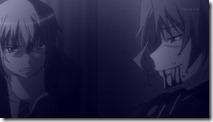

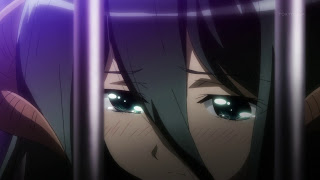
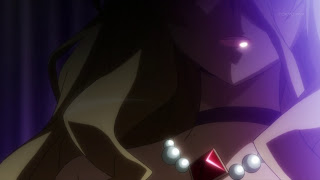
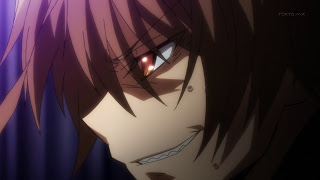
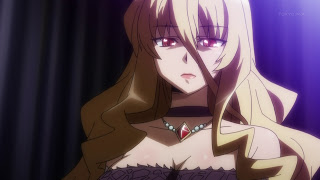
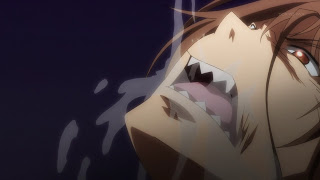
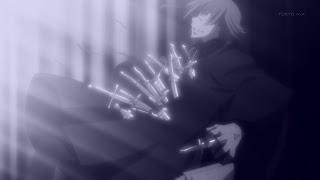



sonicsenryaku
May 30, 2013 at 8:23 pmThis episode was handled extremely well; this was primarily an aftermath episode and again, it is always a wise decision to take the time to flesh out the characters and illustrate the personal turmoils presented to them as they face true dark side of Gossip's game. It's this moment that really hammers in the disturbing truth to Kiri and Iwai that they could lose each other at any moment, culminating in that intense, sensual scene which i felt was handled brilliantly. Hmmmmm, yep no anime cliches here at all; just good all fashion human interaction.
Im pretty sure if that had gone further they might have actually had sex, to which again this series doesnt just shove that prospect within the viewers face, but rather allude to it through the intense feelings they have for each other and just present it just a natural thing for two people who are in love to do (that's assuming they are in love which i think it's kind of obvious….though kashiko is still around so let's see how this series will play on that). On a side note, animation-wise, i agree that from an asthetic and artistic perspective, it is truly radiant. My only complaint would be that the fluidity of the animation like character movements and changes in expressions can be inconsistent from time to time but not frequently and definetly not enough to hurt this series.
MCAL
May 30, 2013 at 9:29 pmThe final scene between Kiri and Iwai was indeed perfect. Very sensual and nicely done. Especially loved the fact that Kiri assured Iwai that their intimate moment was due to his true feelings of love and not as just a form of comfort. A shame people seem to be liking it less (It's now has a lower ranking in MAL than C3 which it has constantly been compared to).
Scruffy
May 30, 2013 at 11:30 pmPeople who rank shows on MAL before it's finished are generally the idiots or the haters. I NEVER rank a show before it's finished.
Anyway .. agree that this episode was awesomely done. Even though the underlying story is nothing particularly special there is just that real special chemistry between the characters. It really is 100% the characters that make this show.
admin
May 31, 2013 at 12:17 amI can't for the life of me see how this series can be compared to C3 of all shows, to be honest. That show rang extremely false from the premiere onward, in a way only LN adaptions can. The character interactions were off-key and the entire story was a mass of cliche. I suppose it looked pretty good, but it had nothing like the originality and stylistic flair of Crime Edge.
The only series I can really compare this to is MGX – it's the only one I've thought of apart from the obvious visual connection to TTGL, with which is shares so many key staff members.
MCAL
May 31, 2013 at 2:51 amTrust me, I'm trying to find out why people compare this to C3 too.
Maxulous
May 30, 2013 at 10:58 pmThe ability to provoke a reaction from an audience … does not, in my view, impart any special meaning on a work of art – it takes skill but is in itself a hollow act. To be able to provoke a reaction using character and pathos, on the other hand, is much more difficult to do and much more rarely achieved. By the same token, it's that much more meaningful when it does happen. For me, Aku no Hana is a glowing example of the latter achievement – it doesn't seek merely to shock the audience for its own sake, but to reveal something about human nature and make us feel something genuine in the process. Clearly this is not the series for everybody, but those few of us that are following it are being treated to something truly strange and beautiful.
hoiut
May 31, 2013 at 8:21 pmThe problem for me is that I'm seriously unsure whether or not AnH is "[seeking] seek merely to shock the audience for its own sake." Sometimes, to be honest, it really seems like it is. Or maybe this supposed depth is just lost on me.
I don't think either C3 or AnH can be compared on the same level with Dansai Bunri. This series seriously stands alone. Any similar thematic threads are superficial at best.
Kiri actually seems pretty sharp (excuse the pun). What an engagingly sensual pleasure it is to watch DB every Thursday, in many ways!
hashi
June 1, 2013 at 6:25 pmIt was seriously pleasing that this episode didn't just tie up the violence and move on, but spent time showing and developing the characters' reactions to what had happened. This is what real drama does.
Simoun was a show whose whole essence was showing how the characters reacted to the events around them. Sword Art Online was a good anime, but ended suddenly, at its climax, leaving me for one unsatisfied.
I have to admit that I was disappointed Kiri couldn't bring himself to kiss her on the lips, or do even more, after such moist sensuality and their realization of their love and danger. It seemed odd, despite the formal notion that they are middle school students.